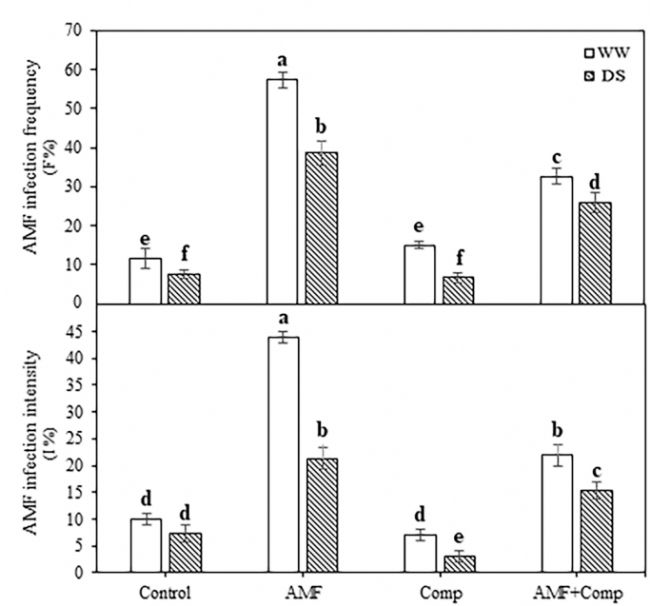通過根系加固提高旱地藜麥的生理特性、生產力和谷物生物活性質量研究
現代農業面臨著多重復雜的挑戰,必須生產更多的食物和纖維來養活不斷增長的人口。越來越多變的天氣和干旱等更極端的事件會降低作物產量。這意味著需要大幅增加產量,采用更高效和可持續的生產方法以及適應氣候變化。提出了一種新的技術和環境友好型管理技術,以提高藜麥生長至成熟的耐受性,使用天然微生物生物刺激劑(叢枝菌根真菌;AMF)單獨、聯合或與堆肥(Comp)結合作為有機物質來源在兩種水處理(正常灌溉和干旱脅迫(DS)下。與對照相比,DS下生長、籽粒產量和所有生理性狀均顯著降低,而過氧化氫、丙二醛和抗氧化酶功能顯著提高。在DS下,與未經處理的植物相比,生物肥料的應用使生理活動恢復到正常水平,并可能增強藜麥對缺水的適應能力。雙重組合使谷物干重提高了 97%。此外,微生物和堆肥生物刺激劑作為生物工具的有效性提高了谷物質量并限制了 DS 下的土壤退化。元素濃度,特別是常量營養素、抗氧化潛力(1,1-二苯基-2-苦基肼自由基清除活性)和生物活性化合物(苯酚和類黃酮含量)在生物肥料處理的藜麥谷物中的積累水平高于未處理的對照。
AMF+Comp 對收獲后土壤肥力性狀的影響最為積極,干旱條件下總磷(47%)和有機質(200%)含量顯著增加。總之,我們的數據表明,干旱脅迫強烈影響藜麥的生理特性、產量和質量。微生物和堆肥生物刺激可能是確保更高恢復能力的有效替代方案,從而保持相對較高的谷物產量。我們的研究表明,藜麥的地上應激反應可以通過來自微生物/堆肥處理根的信號進行調節。此外,與未接種和無堆肥的植物相比,使用 AMF 改良和接種的藜麥谷物通常具有更高的營養品質。

Root Reinforcement Improved Performance, Productivity, and Grain Bioactive Quality of Field-Droughted Quinoa (Chenopodium quinoa)
Abstract: Modern agriculture is facing multiple and complex challenges and has to produce more food and fiber to feed a growing population. Increasingly volatile weather and more extreme events such as droughts can reduce crop productivity. This implies the need for significant increases in production and the adoption of more efficient and sustainable production methods and adaptation to climate change. A new technological and environment-friendly management technique to improve the tolerance of quinoa grown to maturity is proposed using native microbial biostimulants (arbuscular mycorrhizal fungi; AMF) alone, in the consortium, or in combination with compost (Comp) as an organic matter source under two water treatments (normal irrigation and drought stress (DS)). Compared with controls, growth, grain yield, and all physiological traits under DS were significantly decreased while hydrogen peroxide, malondialdehyde, and antioxidative enzymatic functions were significantly increased. Under DS, biofertilizer application reverted physiological activities to normal levels and potentially strengthened quinoa’s adaptability to water shortage as
compared to untreated plants. The dual combination yielded a 97% improvement in grain dry weight. Moreover, the effectiveness of microbial and compost biostimulants as a biological tool improves grain quality and limits soil degradation under DS. Elemental concentrations, particularly macronutrients, antioxidant potential (1,1-diphenyl-2- picrylhydrazyl radical scavenging activity), and bioactive compounds (phenol and flavonoid content), were accumulated at higher levels in biofertilizer-treated quinoa grain than in untreated controls. The effects of AMF+Comp on post-harvest soil fertility traits were the most positive, with significant increases in total phosphorus (47%) and organic matter (200%) content under drought conditions. Taken together, our data demonstrate that drought stress strongly influences the physiological traits, yield, and quality of quinoa. Microbial and compost biostimulation could be an effective alternative to ensure greater recovery capability, thereby maintaining relatively high levels of grain production. Our study shows that aboveground stress responses in quinoa can be modulated by signals from the microbial/compost-treated root. Further, quinoa grains are generally of higher nutritive quality when amended and inoculated with AMF as compared to non-inoculated and compost-free plants.
Pessl植物生理生態監測系統的全套監測系統和在線平臺FieldClimate適用于所有氣候區,可用于各種行業和各種用途——從農業到研究、水文、氣象、洪水警報等。iMetos植物生理生態監測系統已經成為一個全球品牌,使用持續時間更長,性能更好,是通用的天氣監測設備,具有早期識別和警報功能(有SMS手機提醒功能);可以用來計劃、控制和管理復雜的獨立氣象過程。該監測系統專為不同氣候區域的多種任務而設計。其可以安裝多達600個傳感器,如土壤和空氣濕度、溫度、降雨、風速、風向、葉片 濕度、總體輻射等傳感器。






